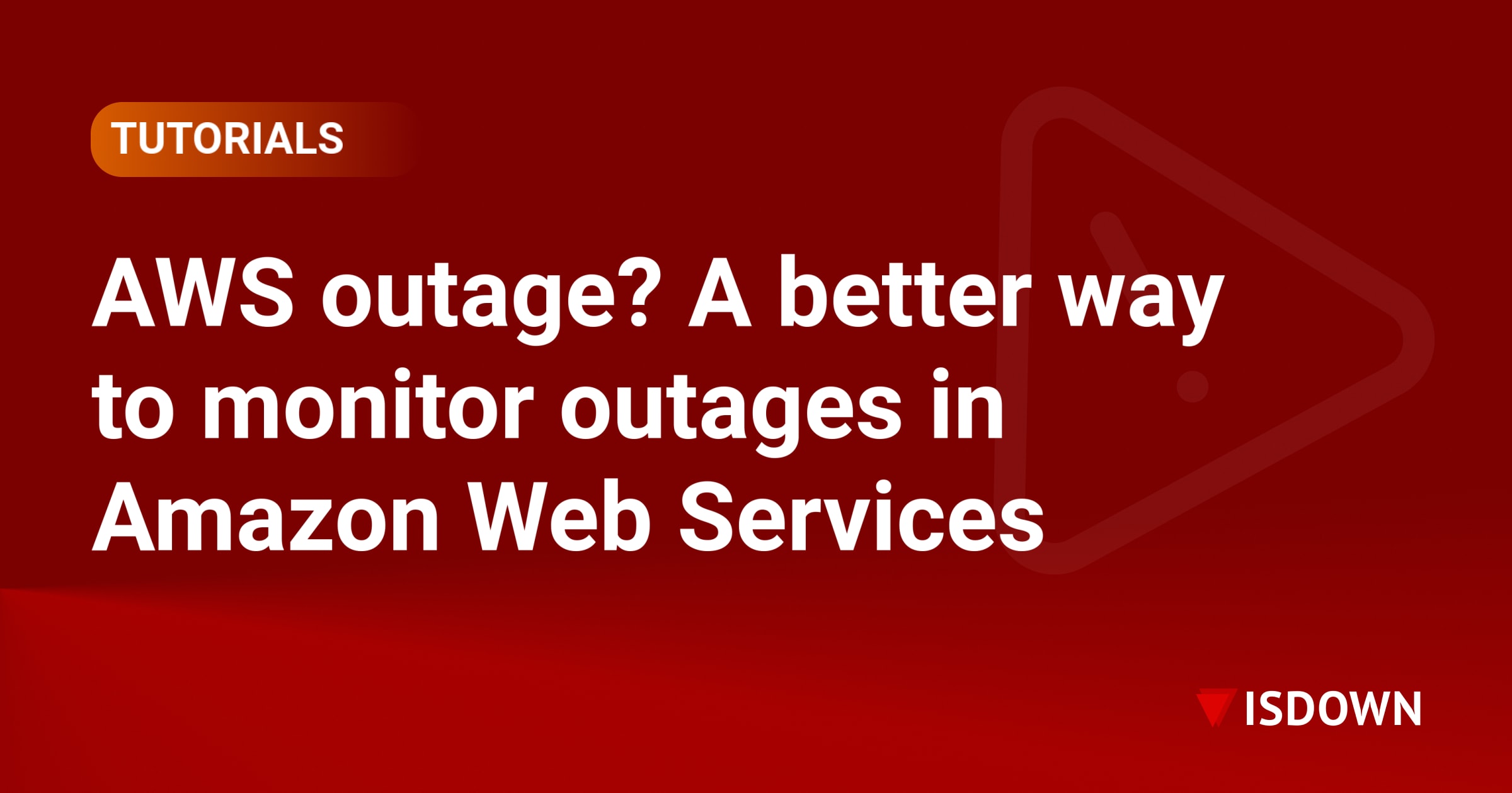Top EagleStatus Alternatives for 2025: Comprehensive Third-Party Monitoring Tools

A lot of us rely on a variety of third-party services and cloud providers for essential operations for personal use or business functions. These include SaaS tools for CRM, cloud services for hosting websites, and many other tools that support daily activities.
Service outages can disrupt workflows and cause delays. Early detection helps reduce the impact. Tools like EagleStatus provide real-time monitoring and instant alerts to keep users informed.
What is EagleStatus?

EagleStatus tracks real-time uptime data from cloud service providers. It provides a status page and official updates, including early warning signals. This helps keep users informed about the health of services from their providers. It further allows them to respond swiftly to disruptions.
While it provides essential monitoring features, EagleStatus may not meet everyone's needs. Some users may require more advanced features, broader service coverage, or deeper integrations with their existing tools. Fortunately, several alternatives offer enhanced functionality.
EagleStatus offers a free plan, with paid tiers starting at $7/month for Basic, $29/month for Pro, and $69/month for Premium, catering to different monitoring needs. However, businesses with specific requirements may find greater flexibility in other platforms.
Here are a few things you might find:
Advanced Features. Some alternatives, like IsDown, provide customizable status pages, detailed outage logs, and more granular notification options.
Better Integration. There are tools that integrate seamlessly with platforms like Slack or incident management systems.
Customization. Some alternatives may allow more flexibility when it comes to alerting or status page designs.
Real-Time Notifications. Certain tools offer smarter, more specific notifications that help businesses address issues quickly.For the top alternatives, dive right in.
What are the Top EagleStatus Alternatives?
1. IsDown

IsDown is an all-in-one monitoring solution that tracks the status of over 3,700 cloud and SaaS providers. It offers an easy-to-use dashboard where businesses receive up-to-the-minute notifications about outages and service disruptions.
Key Features:
Public & Private Status Pages: Businesses can share status updates with teams or customers with customizable domains and branding.
Smart Alerts: Notifications filter by service, severity, or downtime.
Seamless Integration: IsDown works with popular platforms like Slack and PagerDuty.
Advantages:
IsDown offers a comprehensive approach to tracking service uptime.
It simplifies monitoring processes.
It provides up-to-the-minute notifications and a customisable dashboard.
It offers a free status page aggregator for small teams and a trial for advanced features.
Disadvantages:
- Pricing may be prohibitive for very small businesses.
Pricing:
- Paid plans start at $37/month.

2. IncidentHub

IncidentHub aggregates service status from major SaaS and cloud providers. It offers real-time notifications during outages.
Key Features:
Third-Party Incident Communication: It integrates with Slack to send real-time outage alerts.
Incident Management: It helps teams manage outages and reduce downtime.
Advantages:
It provides an easy-to-use platform.
It is great for businesses that need basic monitoring and Slack integration.
Disadvantages:
May lack advanced features compared to all-in-one solutions.
Focus primarily on SaaS and cloud providers; may not cover all monitoring needs.
Pricing:
- The paid plan is $19 per month or $190 per year if paid annually.

3. StatusSight

StatusSight offers a simple dashboard that aggregates service status from cloud technology providers.
Key Features:
- Simple Interface: It focuses on providing an easy-to-read status page.
Advantages:
- It is great for businesses looking for a basic, no-frills status checker.
Disadvantages:
Limited features compared to more comprehensive solutions.
May not be suitable for businesses with complex monitoring needs.
Pricing:
- Paid features are available on request.
4. Downdetector

DownDetector uses crowdsourced outage reports to provide real-time outage maps.
Key Features:
- Crowdsourced Data: Relies on user reports to identify outages.
Advantages:
It's very popular, so it can capture a lot of crowdsourced data.
It is a useful tool for understanding widespread service issues.
Disadvantages:
Accuracy depends on user reports and may not be reliable for all services.
Lacks proactive monitoring, making it less reliable for real-time updates. Businesses needing a more comprehensive solution can explore alternatives with direct status page integrations.
Pricing:
- Free for basic use. Needs to contact the team for Enterprise plans.
5. Outage.Report

Outage.Report is a crowdsourced outage monitoring platform that provides real-time service status updates across multiple countries. Users can access historical data, outage maps, and social media updates to stay informed.
Key Features:
Crowdsourced Outage Tracking: Relies on user reports to detect service issues in real-time.
Recent Outage History: Displays reports from the past 48 hours for quick access to ongoing trends.
Global Coverage: Monitors outages in nine different countries with localized service lists.
Outage Maps & Twitter Feeds: Visualizes disruptions geographically and aggregates social media posts.
User Interaction: A comments section allows users to report issues and discuss service disruptions.
Multilingual Support: Available in multiple languages for a broader audience.
Advantages:
Completely free to use for all users.
Fast reporting on outages based on real-time user feedback.
Historical outage data allows users to identify recurring service issues.
Global tracking with regional service lists.
Disadvantages:
User-reported data only: No direct verification from service providers, which can lead to inaccuracies.
Limited coverage of SaaS and cloud services used by businesses.
Cluttered interface that may feel overwhelming to new users.
Pricing:
- Free Service
6. StatusTicker

StatusTicker is a lightweight monitoring tool that tracks 900+ SaaS and cloud providers, sending real-time alerts for disruptions. It's easy to set up but lacks advanced filtering and customization.
Key Features:
Tracks 900+ cloud and SaaS providers with real-time status updates.
Clean and easy-to-read dashboard for quick insights.
Instant alerts for service disruptions.
Advantages:
Fast and simple setup with minimal configuration.
Covers a wide range of SaaS and cloud services.
Affordable pricing for basic monitoring needs.
Disadvantages:
No support for custom incidents or advanced filtering.
Lacks public and private status page options.
Pricing:
- Starts at $9/month (annual subscription).

7. Is The Service Down

Is The Service Down tracks real-time outages for consumer services like Downdetector, using crowdsourced reports, maps, and a Twitter feed. While great for consumer tracking, it lacks coverage for business-critical SaaS and cloud platforms.
Key Features:
Crowdsourced outage data for real-time updates.
Categorized reports to clarify service issues.
24-hour outage history with a timeline view.
Map view to show affected regions.
Live Twitter feed and user comments for instant insights.
Advantages:
Free to use for all users.
Visual outage tracking with interactive maps.
Live updates from Twitter and user reports.
Disadvantages:
Consumer-focused with limited SaaS and cloud provider coverage.
Crowdsourced data lacks official confirmation.
Heavy use of ads affects the user experience.
Pricing:
- Free Service
8. OutLogger

OutLogger tracks past service outages and logs incidents for future analysis.
Key Features:
- Detailed Outage Logs: It provides insights by tracking and analysing past outages.
Advantages:
- It is a cost-effective solution for businesses that need to track service disruptions but don't require complex monitoring.
Disadvantages:
Does not offer real-time monitoring or alerting.
Primarily a logging tool, not a comprehensive monitoring solution.
Pricing:
- Starts at $15/month.
Features to Consider When Choosing an EagleStatus Alternative
When selecting an alternative to EagleStatus, consider these features:
Comprehensive Monitoring. The tool should cover SaaS services, websites, and APIs important for business operations.
Real-Time Alerts. Choose a tool that delivers instant notifications when service disruptions occur.
Public & Private Status Pages. A status page helps businesses keep both teams and customers informed during outages.
Integration with Existing Tools. Make sure the tool integrates with platforms like Slack, PagerDuty, or other incident management systems.
Why Is Monitoring Third-Party Services Important for Your Business?
Third-party services play a crucial role in many businesses. If these services experience disruptions, the business may also face negative effects. Here's why monitoring these services is essential:
Minimize Downtime Impact. Identifying disruptions early can help reduce the duration and impact of downtime.
Maintain Communication. Tools with incident communication features allow teams and customers to stay informed during service interruptions.
Track Dependencies. Monitoring helps businesses keep track of services that depend on each other. This lets them prepare for any potential disruptions.
Find the Right Monitoring Solution with IsDown
Monitoring third-party service outages is critical for businesses that rely on cloud providers and SaaS platforms. While EagleStatus offers real-time monitoring, it may lack advanced features and integrations that some businesses need.
Among the alternatives, IsDown stands out as a business-focused solution with real-time alerts, aggregated service data, and seamless integrations. It combines official updates and crowdsourced insights to provide accurate, timely notifications, helping teams respond quickly and minimize downtime.
Whether you're a SaaS provider, DevOps engineer, or IT team, the right monitoring tool can streamline incident response and improve service reliability. Try IsDown's 14-day free trial to experience smarter outage tracking and better business continuity.
FAQs for EagleStatus Alternatives
What are some affordable alternatives to EagleStatus?
Several alternatives and competitors in 2025 offer budget-friendly plans, including:
IncidentHub: starts at $19/month
OneUptime: starts at $20/month
IsDown: starts at $45/month
Can I customize the status pages on alternative tools like I can with EagleStatus?
Yes. Many EagleStatus alternatives, such as IsDown and IncidentHub, offer customizable status pages. IsDown, for example, allows you to tailor your status pages with custom domains and branding to match your business's identity. This ensures your updates are professional and aligned with your company's needs.
Are there any tools that offer better integrations than EagleStatus?
Yes, some alternatives provide stronger integrations with popular platforms. For instance, IsDown integrates seamlessly with Slack and PagerDuty to help you manage incident communications more efficiently. Additionally, IncidentHub also offers Slack integration for real-time updates. These integrations streamline workflows, ensuring your team stays informed without switching between tools.
How do I know which EagleStatus alternative is right for my business?
Choosing the right alternative depends on your specific needs:
If you need basic monitoring, StatusTicker may be sufficient.
For more advanced features like detailed outage logs, IsDown provides enhanced functionality. IsDown also stands out if you need both advanced features (like smart alerts and customizable dashboards) and reliable integrations with team collaboration tools.
If you require specialized website and API monitoring, consider OneUptime.
Are there free plans available for any of the EagleStatus alternatives?
Yes. Several alternatives offer free plans. Downdetector, Outage.Report and Is The Service Down are among the widely used free plans. Most of these alternatives also offer trial periods and free plans for small teams if you're looking to test out the platform before committing to a paid plan.
How do I monitor both my internal systems and external services?
Tools like IsDown and IncidentHub allow businesses to monitor internal systems alongside third-party services by creating custom incidents. These tools help impact your business by ensuring you stay ahead of service disruptions that could cause downtime.
Can I track past outages with any EagleStatus alternatives?
Yes, OutLogger provides detailed logs and historical data on outages affecting critical services. IsDown also delivers real-time notifications, incident history, and official status updates to help businesses analyze past disruptions and improve response times.
 Nuno Tomas
Founder of IsDown
Nuno Tomas
Founder of IsDown





